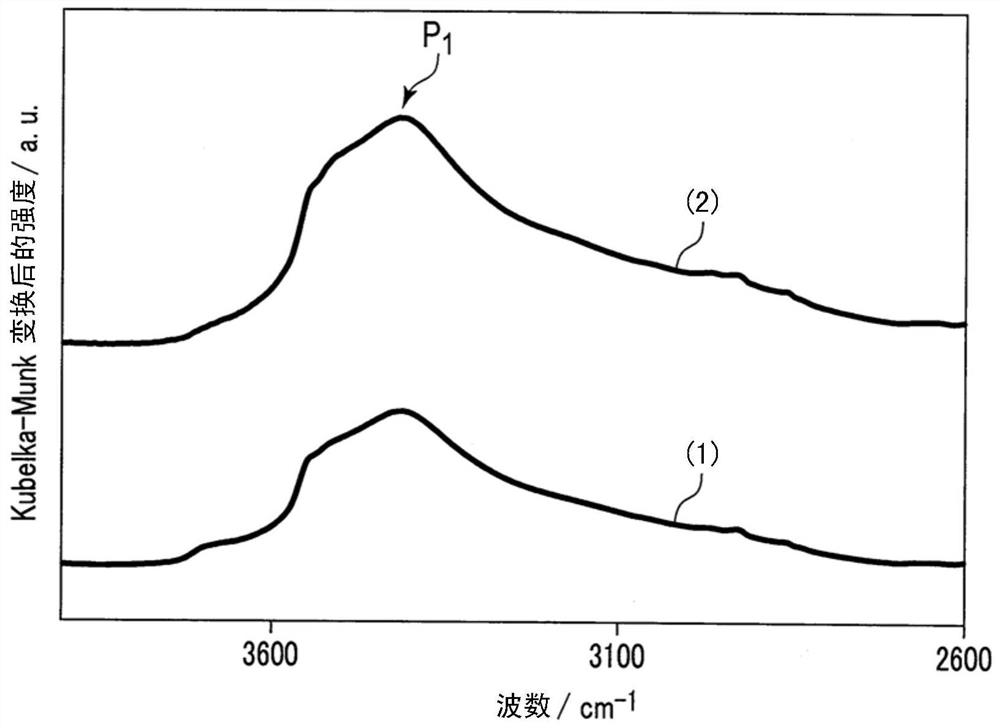Active material, non-aqueous electrolyte battery, battery pack and vehicle
A technology of non-aqueous electrolyte and negative active material, applied in non-aqueous electrolyte storage battery, traction of battery/battery, small-sized battery/battery pack, etc., can solve the problem of low battery voltage and achieve the effect of high reversible capacity
- Summary
- Abstract
- Description
- Claims
- Application Information
AI Technical Summary
Problems solved by technology
Method used
Image
Examples
no. 1 Embodiment approach
[0027] According to the first embodiment, there is provided an active material including particles of Na-containing niobium-titanium composite oxide having an orthorhombic crystal structure. In the infrared diffuse reflectance spectrum measured by the diffuse reflectance Fourier transform infrared spectroscopy on the surface of the particles of Na-niobium-titanium composite oxide, at 3350 to 3450 cm -1 The strongest peak in the range of P 1 The peak intensity of I 1 1.6 or less.
[0028] The active material according to the first embodiment can be used, for example, as an active material for batteries.
[0029] The average operating potential of the Na-niobium-titanium composite oxide having an orthorhombic crystal structure contained in the active material according to the first embodiment may be 1.2 to 1.4 V (vs. Li / Li + ). This working potential is a low value even in titanium composite oxides. Therefore, the active material according to the first embodiment containing...
no. 2 Embodiment approach
[0119] According to the second embodiment, there is provided a nonaqueous electrolyte battery. The nonaqueous electrolyte battery includes a negative electrode, a positive electrode, and a nonaqueous electrolyte. The negative electrode contains the active material according to the first embodiment.
[0120] The non-aqueous electrolyte battery according to the second embodiment may further include a separator arranged between the positive electrode and the negative electrode. The positive electrode, the negative electrode and the separator can constitute an electrode group. A non-aqueous electrolyte may be held in the electrode group.
[0121] In addition, the non-aqueous electrolyte battery according to the second embodiment may further include an exterior member for accommodating the electrode group and the non-aqueous electrolyte.
[0122] In addition, the non-aqueous electrolyte battery according to the second embodiment may further include a positive terminal electrical...
no. 3 Embodiment approach
[0179] According to a third embodiment, a battery pack is provided. This battery pack includes the nonaqueous electrolyte battery according to the second embodiment.
[0180] The battery pack according to the third embodiment may include one or more of the non-aqueous electrolyte batteries (single cells) according to the second embodiment described above. The plurality of non-aqueous electrolyte batteries that can be included in the battery pack according to the third embodiment can be electrically connected in series, in parallel, or in combination. A plurality of non-aqueous electrolyte batteries can also be electrically connected to form a battery pack. The battery pack according to the third embodiment may include a plurality of assembled batteries.
[0181] The battery pack according to the third embodiment may further include a protection circuit. The protection circuit controls the charge and discharge of the non-aqueous electrolyte battery. Alternatively, a circuit...
PUM
| Property | Measurement | Unit |
|---|---|---|
| specific surface area | aaaaa | aaaaa |
| thickness | aaaaa | aaaaa |
| particle size | aaaaa | aaaaa |
Abstract
Description
Claims
Application Information
 Login to View More
Login to View More - R&D
- Intellectual Property
- Life Sciences
- Materials
- Tech Scout
- Unparalleled Data Quality
- Higher Quality Content
- 60% Fewer Hallucinations
Browse by: Latest US Patents, China's latest patents, Technical Efficacy Thesaurus, Application Domain, Technology Topic, Popular Technical Reports.
© 2025 PatSnap. All rights reserved.Legal|Privacy policy|Modern Slavery Act Transparency Statement|Sitemap|About US| Contact US: help@patsnap.com



